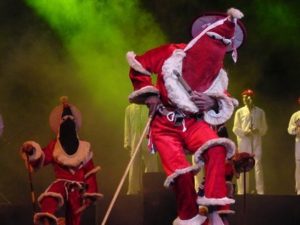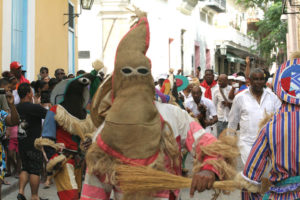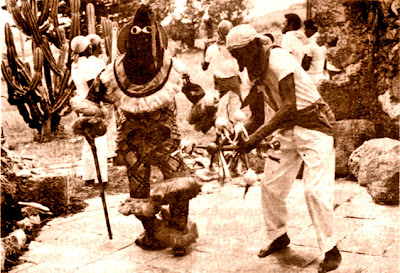 THE ABAKUÁ SECRET SOCIETY: MYSTERIES AND FEAR.
THE ABAKUÁ SECRET SOCIETY: MYSTERIES AND FEAR.
The Abakuá Secret Society of Cuba, formed only by men, the great majority of the black race, is the only one of its kind in Latin America and since its origins in the nineteenth century embodied a culture of resistance against slavery imposed by Spain during the colonial era.
The first group built in 1836 in the ultramarine town of Regla in the vicinity of Havana, has its antecedents in the Nigerian region of Calabar, where human sacrifices and anthropophagy were common practices, among the members of the tribes as a tribute to your gods
The warriors were forced to sharpen their teeth with files and hammers and to injure themselves in different parts of the body, including mutilation, as a sign of identity, but as wisely pointed out by the historian Enrique Sosa, those constitions did not survive in the largest of the Antilles .
However, they influenced the terror and respect inspired by the abakuás in Cuba and other places in the world, influenced by slander and exaggerations raised during the colonial and pseudo-republic stage, as well as misunderstandings that have triggered the precocious imagination of many authors around the subject.
That is the reason why it is speculated that the cult of the ñáñigos, as the abakuás are also known in the small Caribbean country, is more feared than the voodoo, more rigid than the mayombe, bloodier than the candomblé and stricter than Santeria, with the marked interest of distorting reality.
The abakuás has strict liturgical norms, linked to African religious beliefs and the drums (Ekue) are part of the ceremony.
It is true that the absence of a solid ideological base, caused this cultural group to be linked to antisocial activities such as delinquency, machismo, guapería and petulancia, typical of slums, prone to lipid and stabbing, in between of the aggressiveness of the surrounding environment.
The abakuá is a man to everything, and the mere fact of belonging to the feared institution gives its members a patent to act freely in “the environment” a trend that increased during the decade of the 70s of the twentieth century, with the entry of low moral elements and criminal records.
The Abakuá Society, recognized for the first time in 1906 by the ethno-anthropologist Fernando Ortiz, in his book “Los Negros Brujos” claims faultless behavior at home, work and community, although there is certainly a distorted image about it .
The godfather is the person indicated to observe the behavior of his godchildren and future candidates for initiation, which was banned in Cuba, between 1967 and 1977 and today when a plant or ceremony of swearing is carried out, authorization must be requested from the police authorities.
Currently, the center of Abakuá activity is located in the provinces of Havana and Matanzas, located in the western portion of the Cuban archipelago, where some 40 temples operate, distributed in the municipalities of Guanabacoa, Regla, Marianao, San Miguel del Padrón and Cárdenas.
Among the famous abakuás figure; Miguel Fayde, composer of the first danzón, the violinist Claudio Domingo Brindis de Salas, who was called “the Black Paganini” the musician Ignacio Piñero, the famous ballplayer Martín Dihigo, the sonero Chano Pozo and the Poéta Jesús Orta Ruiz, known as El Indio Naborí.
The ñañiguismo, riddled with enigmas, has own voices as ecobio or monina (brother) ocambo (old) moropo (head) naue (friend) and paripé (paper) among others and there are many artists who have inspired their works in this organization ; like the pianists Miguel Enriquez and Mariano Rodríguez and the singer Pedro Luis Ferrer.

Los espíritus son convocados por los ñáñigos para desarrollar el ritual religioso representados simbólicamente por Ireme o diablitos.
La Sociedad Secreta Abakuá de Cuba, formada sólo por hombres, en su gran mayoría de la raza negra, es la única de su tipo en la latinoamérica y desde sus orígenes en el siglo XIX encarnó una cultura de resistencia contra la esclavitud impuesta por España durante la época colonial.
El primer grupo constiuido en 1836 en el ultramarino poblado de Regla en las cercanías de La Habana, tiene sus antecedentes en la región nigeriana de Calabar, donde los sacrificios humanos y la antropofogía, eran prácticas habituales, entre los integrantes de las tribus como tributo a sus dioses.
Los guerreros eran obligados a afilarse los dientes con limas y martillos y a propinarse heridas en diveras parte del cuerpo, incluida la mutilación, como señal de identidad, pero como apunta sabiamente el desaparecido historiador Enrique Sosa, esas constumbres no sobrevivieron en la mayor de las Antillas.
Sin embargo influyeron en el terror y el respeto que inspiran los abakuás en Cuba y otros sitios del mundo, al influjo de calumnias y exageraciones enarboladas durante la etapa colonial y la seudorepública, así como equívocas interpretaciones, que han disparado la precoz imaginación de muchos autores alrededor del tema.
Esa es la razón por la cual se especula que el culto de los ñáñigos, como también son conocidos los abakuás en el pequeño país caribeño, es más temido que el vodú, más rígido que el mayombe, más sangriento que el candomblé y más estricto que la santería, con el marcado interés de tergiversar la realidad.
Los abakuás tiene rigurosas normas litúrgicas, vinculadas a las creencias religiosas africanas y los tambores(Ekue) forman parte de la ceremonia.
Es cierto que la ausencia de una base ideológica sólida, propició que este grupo cultural se vinculara a actividades antisociales como la delincuencia, el machismo, la guapería y la petulancia, propias de los barrios marginales, proclives a la lipidia y las puñaladas, en medio de la agresividad del medio circundante.
El abakuá es hombre a todo, y el sólo hecho de pertenecer a la temida institución dota a sus miembros de una patente de corso para actuar libremente en “el ambiente” una tendencia que se acrecentó durante la década de los años 70 del siglo XX, con la entrada de elementos de baja moral y con antecedentes penales.
La Sociedad Abakuá, reconocida por vez primera en 1906 por el etno-antropólogo Fernando Ortiz, en su libro”Los Negros Brujos” reclama de sus componentes intachable conducta en el hogar, el trabajo y la comunidad, aunque ciertamente existe una imagen distorsionada al respecto.
El padrino es la persona indicada para observar el proceder de sus ahijados y futuros candidatos a la iniciación, que estuvo prohibida en Cuba, entre 1967 y 1977 y hoy en día cuando se realiza un plante o ceremonía de juramentación hay que pedir obligatoriamente autorización a las autoridades policiales.
Actualmente el centro del quehacer abakuá se ubica en las provincias de La Habana y Matanzas, localizadas en la porción occidental del archipiélago cubano, donde funcionan unos 40 templos, distribuidos en los municipios de Guanabacoa, Regla, Marianao, San Miguel del Padrón y Cárdenas.
Entre los abakuás célebres figuran; Miguel Fayde, compositor del primer danzón, el violinista Claudio Domingo Brindis de Salas, a quien llamaban “el Paganini Negro” el músico Ignacio Piñero, el afamado pelotero Martín Dihigo, el sonero Chano Pozo y el Poeta Jesús Orta Ruiz, conocido como El Indio Naborí.
El ñañiguismo, cuajado de enigmas, cuenta con voces propias como ecobio o monina( hermano) ocambo (viejo) moropo(cabeza) naue (amigo) y paripé (papel) entre otras y son muchos los artistas que han inspirados sus obras en esta organización; como los pìntores Miguel Enriquez y Mariano Rodríguez y el cantante Pedro Luis Ferrer.
Agencies/Arrajatabla/Alberto Denis/Internet Photos/ Arnoldo Varona/ TheCubanHistory.com
THE CUBAN HISTORY, HOLLYWOOD.










